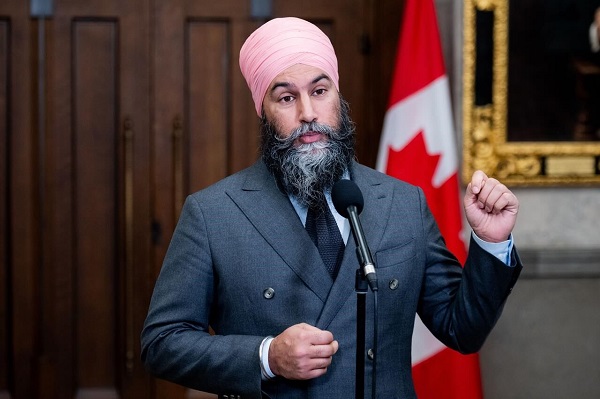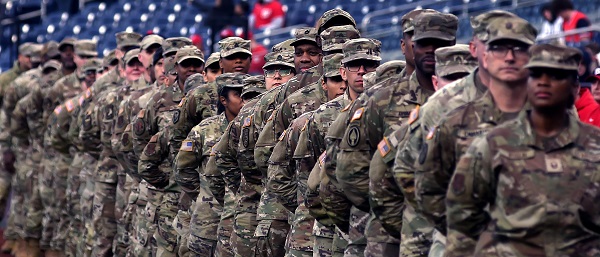conflict
Canada’s ceasefire motion is much ado about nothing

From the Frontier Centre for Public Policy
“On Monday the NDP has a motion that it pitches as a call for a ceasefire. It does so without demanding Hamas surrender & no longer rule Gaza. It also calls for a litany of other things hostile to Israel. Changing foreign policy to reward a terrorist attack. Not smart”.
Canada was thoroughly embarrassed last fall when a former Nazi was applauded in Parliament.
So why are Liberals now shaking hands with a notorious Holocaust denier?
Or openly praising a Hamas zealot who joked about baking a Jewish baby with baking powder, as MP Heather McPherson did when she introduced the Gaza ceasefire motion?
These are some of the questions we can ask after watching the heated House of Commons debate that took place on March 19, 2024. In what looked more like an amateur debating contest, many speakers appeared to be trying to outdo one another in how pro-Hamas they could be.
The motion was opposed by every Conservative, as well as by three Liberals. One of them, Anthony Housefather, is now contemplating his future with the Liberal Party. Here is how he described the motion that was passed:
“On Monday the NDP has a motion that it pitches as a call for a ceasefire. It does so without demanding Hamas surrender & no longer rule Gaza. It also calls for a litany of other things hostile to Israel. Changing foreign policy to reward a terrorist attack. Not smart”.
And he is exactly right.
Every Canadian wants the war to stop. No one wants to see innocent Palestinians die. However, that will require that the hostages be returned, and Hamas to lay down its arms. That has been Canada’s policy from the beginning of the Oct 7, 2023 conflict. Defence Minister Bill Blair was absolutely clear about Canada’s position, when he said this about Israel, shortly after the Oct 7 attack:
“I think they have a right to defend themselves against that terrorist threat. And quite frankly, Hamas has to be eliminated as a threat not just to Israel but to the world. They are a terrorist organization.”
That is the official position of Canada, and it has never changed. But now, in this non-binding – and largely meaningless – motion the Liberals who supported it have condemned Israel instead of properly putting the blame on Hamas – the terrorist group that caused the single worst pogrom since the Holocaust
It is extremely important to remember in all of this verbiage that Hamas was, and is, a designated terrorist organization in Canada, and the rest of the Free World. It is also extremely important to remember that Hamas is a proxy of Iran.
However, all of the words wasted on this debate are essentially hot air. Canada’s official position has not changed – Israel has the right to defend itself. To do that, Hamas must be eliminated.
Not that a great deal would change even if Canada’s official position on Israel was altered. Canada was a leader on the world stage at one time. Those days are long gone. The motion is for a domestic audience. It shows the Liberals trying to have it both ways. They are trying to appease their more radical fringe, while not getting Canadian Jews and other Canadians who support Israel not too mad at their obvious hypocrisy. Actual government policy calls for the elimination of Hamas, but Liberals don’t want to say so.
We see Joe Biden and his Democrats doing the same thing – strongly criticizing Israel and its elected leader while the official American position is that Israel has a right to defend itself – which includes eliminating Hamas as a threat. Biden made his staunch support for Israel very clear after the Oct 7 massacre. Despite his equivocation since that time, official American policy towards Israel has not changed. Biden, and Democrats, like Chuck Schumer, are playing to their audiences in sensitive electoral areas, like Michigan with their recent anti-Israel rhetoric. But those are performances for their local audience, as opposed to official policy changes.
What is really important is the U.S. Security Council veto. As long as America continues to veto demands for an immediate ceasefire Israel can continue its legitimate, methodical campaign to eliminate Hamas in Gaza. To date it has taken extraordinary precautions to avoid unnecessary civilian casualties, in spite of Hamas’ shocking use of human sacrifice – namely innocent Palestinians – to achieve its goals.
It doesn’t appear that a ceasefire motion that will include terms demanded by the U.S., such as an unequivocal condemnation of Hamas’s barbaric Oct 7 attack, and an immediate release of the hostages, will happen any time soon.
Unless that changes the heated political speeches and increasingly violent protests we see and hear everywhere are just noise. Israel is determined to finish what it has started.
The Oct 7 attack has profoundly shaken Israel to its core. Except for fringe voices, those Israelis who had once hoped that Hamas would eventually morph into a peaceful neighbor have come to the painful realization that it is – in crude terms – “kill or be killed”. They are not going to stop until Hamas is eliminated as an existential threat to their survival. Any nation would do the same if faced with a threat to their very survival.
So, even if the United States should withdraw its Security Council veto the Israelis would probably continue until the job is done – for the simple reason that they have no choice. They are determined to get the job done. The future of Netanyahu will be determined only after the war is over.
The heated words, street demonstrations and politically-charged ceasefire motions will be around for a while, but they are largely much ado about nothing. What is not much ado about nothing is Israel’s certain knowledge that if they don’t destroy Hamas, it will destroy them.
Brian Giesbrecht, retired judge, is a Senior Fellow at the Frontier Centre for Public Policy
Artificial Intelligence
AI Drone ‘Swarms’ Unleashed On Ukraine Battlefields, Marking New Era Of Warfare


From the Daily Caller News Foundation
Artificial intelligence-powered drones are making their first appearances on the battlefield in the Russia-Ukraine war as warfare creeps closer to full automation.
In bombardments on Russian targets in the past year, Ukrainian drones acting in concert were able to independently determine where to strike without human input.
It’s the first battlefield use of AI “swarm” technology in a real-world environment, a senior Ukrainian official and Swarmer, the company who makes the software, told the Wall Street Journal in a Tuesday report. While drones have increasingly defined modern battlefields, swarms until now had been confined to testing rather than combat.
“You set the target and the drones do the rest,” Swarmer Chief Executive Serhii Kupriienko told the WSJ. “They work together, they adapt.”
So far, the Swarmer technology has been used hundreds of times to target Russia assets, but was first used a year ago to lay mines on the front, the Ukrainian official told the WSJ. The software has been tested with up to 25 drones at once, but is usually utilized with only three.
Kupriienko told the WSJ that he was preparing to test up to 100 drones at once with the linking software.
A common arrangement used on the battlefield includes one reconnaissance drone to scout out the target and two explosive drones delivering the payload on target, the official told the WSJ.
While Western nations such as the U.S., France and the United Kingdom are also pursuing drone swarm technology, they have not deployed swarm technology on the battlefield the way Ukraine has, according to the WSJ. Currently, autonomous weapons are not regulated by any international authority or binding agreement, but ethical concerns around the technology has led many to call for increased regulation of weapons like the Swarmer system.
The Ukrainian Ministry of Foreign Affairs did not immediately respond to the Daily Caller News Foundation’s request for comment.
conflict
Trump Pentagon Reportedly Blocking Ukraine From Firing Western Missiles Deep Into Russia


From the Daily Caller News Foundation
The Department of Defense has spent months blocking the Ukrainian military from using American and British-made missiles to hit targets deep inside Russia, The Wall Street Journal reported Sunday, citing unnamed U.S. officials.
Undersecretary of Defense for Policy Eldridge Colby reportedly designed the procedure to review requests to carry out the long-range strikes with weapons that are either of U.S. origin or that require American intelligence or use components provided by the U.S., according to the WSJ. Secretary of Defense Pete Hegseth reportedly has the final say on whether Ukrainian forces can use the MGM-140 ATACMS (Army Tactical Missile System) to hit targets in Russia.
The reported blocks on missile strikes coincides with a Trump administration effort to broker a peace deal between Russia and Ukraine. A Pentagon spokesperson declined to comment further on the matter.
BREAKING: President Vladimir Putin reacts to B-2 Flyover pic.twitter.com/1mzVn7DxlW
— Jack Poso 🇺🇸 (@JackPosobiec) August 15, 2025
The Biden administration allowed Ukraine to carry out strikes with ATACMS in November, weeks after President Donald Trump won the 2024 election, the New York Times reported. Trump criticized the move during a December interview with Time magazine.
“It’s crazy what’s taking place. It’s crazy,” Trump said. “I disagree very vehemently with sending missiles hundreds of miles into Russia. Why are we doing that? We’re just escalating this war and making it worse. That should not have been allowed to be done.”
Trump and Russian President Vladimir Putin met in Alaska on Aug. 15 for a summit meeting during which Trump sought to secure a cease-fire in Russia’s war with Ukraine. As Trump greeted Putin, a B-2A Spirit stealth bomber and several fighters carried out a flyover of Elmendorf Air Force Base.
Trump met with Ukrainian President Volodymyr Zelensky and major European leaders on Aug. 18 to update them on the summit.
In July, Trump reached an agreement with NATO where members of the alliance would purchase weapons, including MIM-104 Patriot surface-to-air missiles, and donate them to Ukraine.
-

 Daily Caller2 days ago
Daily Caller2 days agoDemocrats Explicitly Tell Spy Agencies, Military To Disobey Trump
-

 Alberta2 days ago
Alberta2 days agoAlberta on right path to better health care
-

 Daily Caller2 days ago
Daily Caller2 days agoALAN DERSHOWITZ: Can Trump Legally Send Troops Into Our Cities? The Answer Is ‘Wishy-Washy’
-

 Crime1 day ago
Crime1 day ago‘Modern-Day Escobar’: U.S. Says Former Canadian Olympian Ran Cocaine Pipeline with Cartel Protection and a Corrupt Toronto Lawyer
-

 Business1 day ago
Business1 day agoCanada is failing dismally at our climate goals. We’re also ruining our economy.
-

 Alberta2 days ago
Alberta2 days agoAlberta Emergency Alert test – Wednesday at 1:55 PM
-

 Health15 hours ago
Health15 hours agoCDC’s Autism Reversal: Inside the Collapse of a 25‑Year Public Health Narrative
-

 Alberta2 days ago
Alberta2 days agoCarney government’s anti-oil sentiment no longer in doubt









